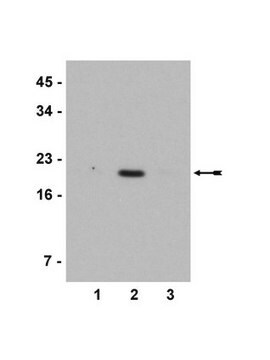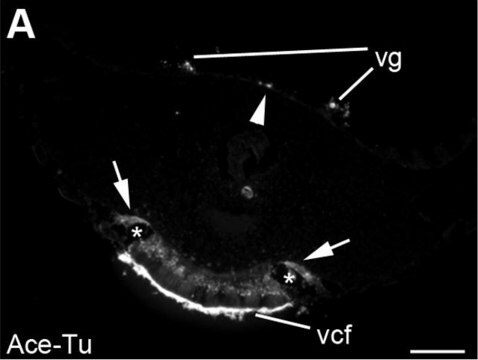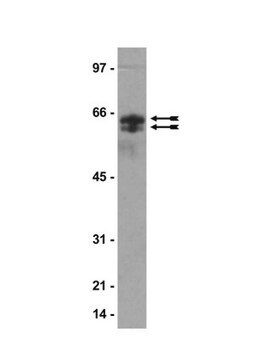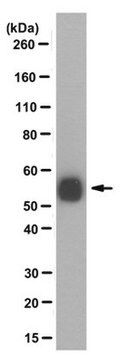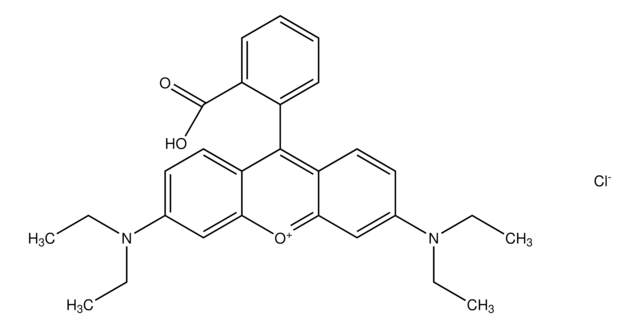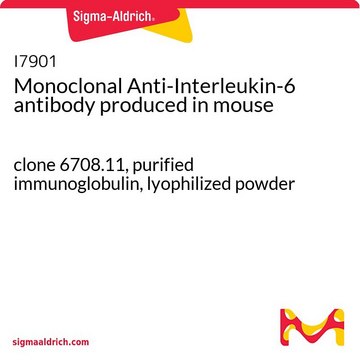MABS277
Anti-monoglycylated Tubulin Antibody, clone TAP 952
clone TAP 952, from mouse
About This Item
Produtos recomendados
fonte biológica
mouse
Nível de qualidade
forma do anticorpo
purified immunoglobulin
tipo de produto de anticorpo
primary antibodies
clone
TAP 952, monoclonal
reatividade de espécies
human, sheep, sea urchin, porcine, mouse, Drosophila, snail
técnica(s)
dot blot: suitable
immunofluorescence: suitable
western blot: suitable
Isotipo
IgG1κ
Condições de expedição
wet ice
modificação pós-traducional do alvo
unmodified
Informações sobre genes
human ... TUBA1A(7846)
Descrição geral
Especificidade
Can be used as a marker for motile cilia.
Imunogênio
Aplicação
Dot Blot Analysis: A representative lot from an independent laboratory detected monoglycylated Tubulin in synthetic monoglycylated tubulin peptides (Bre, M. H., et al. (1996). J Cell Sci. (Pt 4):727-738.).
Western Blot Analysis: A representative lot from an independent laboratory detected monoglycylated Tubulin in a panel of total protein extracts from select species (Bre, M. H., et al. (1996). J Cell Sci. (Pt 4):727-738.).
Immunoflourescence Analysis: A representative lot from an independent laboratory detected monoglycylated Tubulin in lemur, human, and sea urchin spermatozoa (Bre, M. H., et al. (1996). J Cell Sci. (Pt 4):727-738.).
Signaling
General Post-translation Modification
Qualidade
Western Blotting Analysis: A 1:50,000 dilution of this antibody detected monoglycylated Tubulin in 10 µg of Paramecium total cytoskeletal proteins.
Descrição-alvo
forma física
Armazenamento e estabilidade
Outras notas
Exoneração de responsabilidade
Não está encontrando o produto certo?
Experimente o nosso Ferramenta de seleção de produtos.
Código de classe de armazenamento
12 - Non Combustible Liquids
Classe de risco de água (WGK)
WGK 1
Ponto de fulgor (°F)
Not applicable
Ponto de fulgor (°C)
Not applicable
Certificados de análise (COA)
Busque Certificados de análise (COA) digitando o Número do Lote do produto. Os números de lote e remessa podem ser encontrados no rótulo de um produto após a palavra “Lot” ou “Batch”.
Já possui este produto?
Encontre a documentação dos produtos que você adquiriu recentemente na biblioteca de documentos.
Nossa equipe de cientistas tem experiência em todas as áreas de pesquisa, incluindo Life Sciences, ciência de materiais, síntese química, cromatografia, química analítica e muitas outras.
Entre em contato com a assistência técnica